
myCBSEguide App
Download the app to get CBSE Sample Papers 2023-24, NCERT Solutions (Revised), Most Important Questions, Previous Year Question Bank, Mock Tests, and Detailed Notes.
Install NowCBSE Sample Papers Class 11 Biology 2024
You can access CBSE Sample Papers Class 11 Biology for the year 2024 on the myCBSEguide App. myCBSEguide provides CBSE Class 11 Sample Papers of Biology for the session 2023-24 with solutions in PDF format for free download. These model question papers (2023-24) are prepared by experienced biology teachers for class 11 students. That’s why these are the highly recommended papers for your exam preparation.
Download Biology Sample Papers as PDF
Class 11 – Biology Sample Paper (2023-24)
Maximum Marks: 70
Time Allowed: : 3 hours
General Instructions:
- All questions are compulsory.
- The question paper has five sections and 33 questions. All questions are compulsory.
- Section–A has 16 questions of 1 mark each; Section–B has 5 questions of 2 marks each; Section– C has 7 questions of 3 marks each; Section– D has 2 case-based questions of 4 marks each; and Section–E has 3 questions of 5 marks each.
- There is no overall choice. However, internal choices have been provided in some questions. A student has to attempt only one of the alternatives in such questions.
- Wherever necessary, neat and properly labeled diagrams should be drawn.

Class 11 Biology Sample Paper Section A
- Which one is less general in characteristic as compared to the genus?a) Classb) Divisionc) Familyd) Species
- Which one of the following is also known as antidiuretic hormone?a) Calcitoninb) Adrenalinec) Vasopressind) Oxytocin
- Which of the following is not a macromolecule?a) DNAb) Proteinc) Polysaccharided) Lipid
- Stomata is found in which tissue system?a) Vascular tissue systemb) Stomatal tissue systemc) Epidermal tissue systemd) Ground tissue system
- Respiratory process is regulated by certain specialized centres in the brain. One of the following centres can reduce the inspiratory duration upon stimulation:a) Medullary inspiratory centreb) Apneustic centrec) Chemosensitive centred) Pneumotaxic centre
- Which of the following happens during the dark reaction?a) Trapping of light energyb) Carbon fixationc) Formation of PGAd) Formation of ATP and NADPH
To practice more questions & prepare well for exams, download myCBSEguide App. It provides complete study material for CBSE, NCERT, JEE (main), NEET-UG and NDA exams. Teachers can use Examin8 App to create similar papers with their own name and logo.
- Which is the excretory product in eagles?a) Proteinb) Uric acidc) Uread) Ammonia
- Frog shows which kind of excretion?a) Ammonotelic in water and ureotelic on landb) Ureotelicc) Uricotelicd) Ammonotelic
- Higher plants possess specific areas that take part in the formation of new cells. These areas are called ________.a) Permanent tissueb) Meristemsc) Collenchymad) Parenchyma
- The giant Redwood tree (Sequoia sempervirens) is a/an:a) Pteridophyteb) Angiospermc) Free fernd) Gymnosperm
- Urea cycle operates in:a) Liverb) Lungsc) Skin cellsd) Sweat glands and sebaceous glands
- Those bronchioles which divide into alveolar ducts are called as:a) Tertiary bronchiolesb) Secondary bronchiolesc) Primary bronchiolesd) Respiratory bronchioles
- Assertion (A): Microcyst of Myxamoebae lacks a cell wall.
Reason (R): Microcyst is formed in sexual reproduction of cellular slime moulds.a) Both A and R are true and R is the correct explanation of A.b) Both A and R are true but R is not the correct explanation of A.c) A is true but R is false.d) A is false but R is true. - Assertion (A): Aerobic animals are not truly aerobic.
Reason (R): They produce lactic acid anaerobically.a) Both A and R are true and R is the correct explanation of A.b) Both A and R are true but R is not the correct explanation of A.c) A is true but R is false.d) A is false but R is true. - Assertion (A): ATP is called universal energy carrier.
Reason (R): ATP is a nucleotide.a) Both A and R are true and R is the correct explanation of A.b) Both A and R are true but R is not the correct explanation of A.c) A is true but R is false.d) A is false but R is true. - Assertion (A): Respiratory gas exchange occurs through osmosis.
Reason (R): Respiratory gas goes from higher partial pressure region to the region of lower partial pressure.a) Both A and R are true and R is the correct explanation of A.b) Both A and R are true but R is not the correct explanation of A.c) A is true but R is false.d) A is false but R is true. Class 11 Biology Sample Paper Section B
- You are given two slides having T.S. of roots and stems. How will you identify which slide is of root and which is of stem?
- Frogs are beneficial for mankind, justify the statement.
- Which hormone helps maintain the bone density in the body?
- Why there is a need to standardise the system of naming of living organisms?
- 3CO2 + 9ATP + 6NADPH + Water {tex}\to{/tex} glyceraldehyde 3–phosphate +9 ADP+6 NADP++ 8 Pi
Analyze the above reaction and answer the following questions:- How many molecules of ATP & NADPH are required to fix one molecule of CO2?
- Where in the chloroplast does this process occur?
OR
Explain Kranze anatomy.
Class 11 Biology Sample Paper Section C
- What are the industrial uses of algae?
- Differentiate between Exoskeleton and Endoskeleton:
- Enzymes are proteins in which the amino acids are linked to each other by peptide bonds having many functional groups in their structure. As they are weak acids and bases in chemical nature, this ionization is influenced by the pH of the solution. For many enzymes, activity is influenced by the surrounding pH. This is depicted in the curve below, explain briefly.
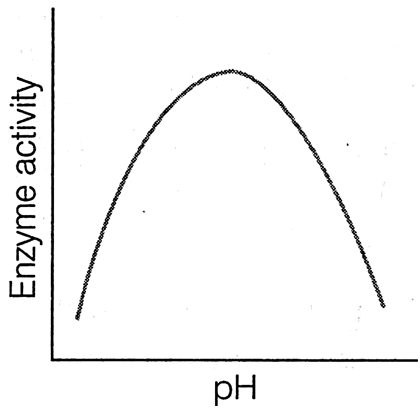
- “The role of ethylene and abscisic acid is both positive and negative”. Justify the statement.
- Give a brief explanation of the human skeletal system.
- Compare mitral valve and semilunar valve.
OR
Explain double circulation.
- Examine the following diagram and answer the following questions:
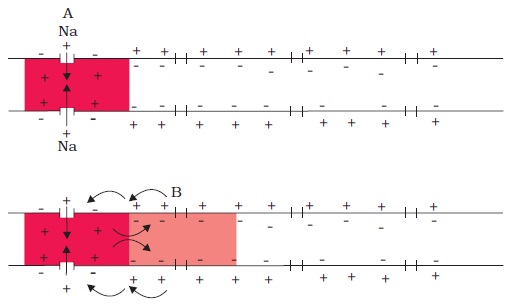
- In which form impulse is carried from point A to point B in the given diagram?
- After an action potential, in which direction does current flow outside the membrane?
- When does given axonal membrane is impermeable to negatively charged proteins present in the axoplasm?
Class 11 Biology Sample Paper Section D
- Read the text carefully and answer the questions:
Sarcodines are unicellular/jelly-like protozoa found in fresh or sea water and in moist soil. Their body lacks a periplast. Therefore, they may be naked or covered by a calcareous shell. They usually lack flagella and have temporary protoplasmic outgrowths called pseudopodia. These pseudopodia or false feet help in movement and capturing prey. They include free-living forms such as Amoeba or parasitic forms such as Entamoeba. Zoo flagellates ciliates and I sporozoans are other groups of protozoan protists. They are all unicellular and heterotrophic. They may be holozoic, saprobic or parasitic.
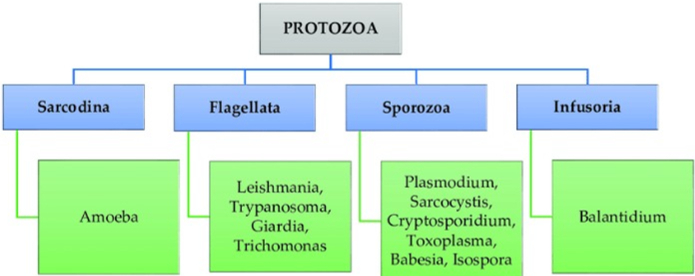
- Write two lines about flagellated protozoans and also mention some flagellated protozoans.
OR
Which protozoan group has two nuclei, macronucleus, and micronucleus? Mention characteristics of it.
- Observe the given protozoan classification and mention what is the basis of protozoan classification.
- Mention some locomotory organs of protozoa.
To practice more questions & prepare well for exams, download myCBSEguide App. It provides complete study material for CBSE, NCERT, JEE (main), NEET-UG and NDA exams. Teachers can use Examin8 App to create similar papers with their own name and logo.
- Read the text carefully and answer the questions:
The androecium is composed of stamens. Each stamen that represents the male reproductive organ consists of a stalk or a filament and an anther. Each anther is usually bilobed and each lobe has two chambers, the pollen-sacs. Stamens of flowers may be united with other members such as petals or among themselves. The stamens may be epipetalous or epiphyllous. A flower is a modified shoot wherein the shoot apical meristem changes to floral meristem. Internodes do not elongate and the axis gets condensed. The apex produces different kinds of floral appendages laterally at successive nodes instead of leaves. The arrangement of flowers on the floral axis is termed an inflorescence.
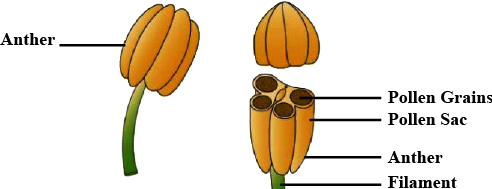
- Observe the figure and mention what is androecium composed of.
- The pollen grains are produced in pollen-sacs. What is a sterile stamen is called?
- Is salvia and mustard show variation in the length of filaments within a flower?
OR
Mention statement justifies that the given figure is racemose inflorescence.
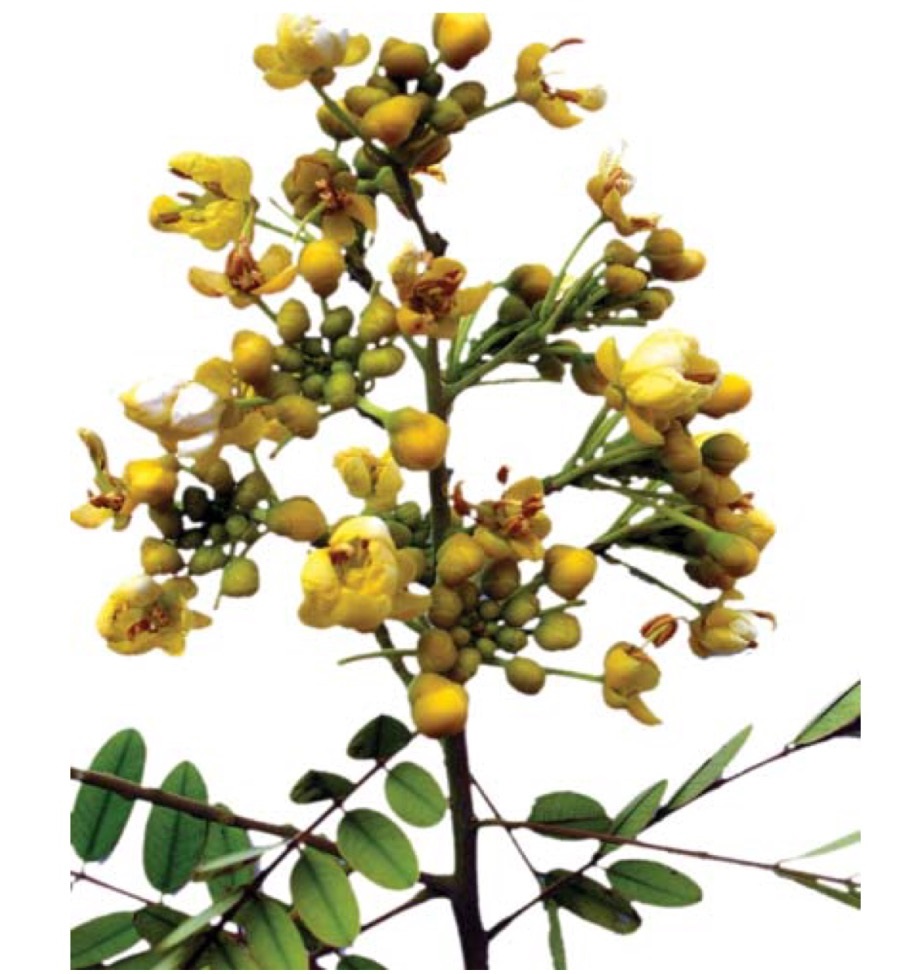
Class 11 Biology Sample Paper Section E
- Describe the following:
- synapsis
- bivalent
- chiasmata
Draw a diagram to illustrate your anwer.
OR
With the help of suitable diagrams describe mitosis.
- Enumerate the assumptions that we undertake in making the respiratory balance sheet. Are these assumptions valid for a living system? Compare fermentation and aerobic respiration in this context.
OR
Where is the electron transport system operative in mitochondria? Explain the system highlighting the role of oxygen.
- The diagram shows some of the structures present in an animal cell.
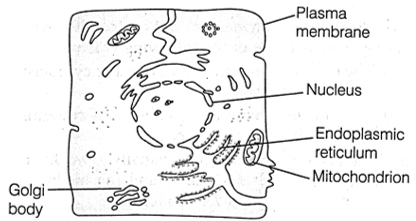
Which of these structures is responsible for- Manufacture of lipids and steroids
- Release of energy
- Manufacture of hormones and digestive enzymes
- Production of spindle fibres in cell division
- Endo and exocytosis?
OR
Structure and function are correlatable in living organisms. Can you justify this by taking the plasma membrane as an example?
Class 11 – Biology Sample Paper Solution (2023-24)
The class 11 Biology syllabus is very vast. Even after reducing and rationalizing the syllabus, you will find that there are still too many chapters. So, only reading through the textbook is not sufficient to score good marks in class 11 Biology.
You must practice the previous year’s papers and sample papers regularly. This model paper will guide you through the format of the actual question paper. You can download many other papers on same format from myCBSEguide app and our student dashboard.
Class 12 Biology Sample Paper Solution Section A
- (b) Division
Explanation: The division is the highest category of hierarchy which contain organisms having only a few common characters. On the other hand, species belonging to the lowest level so, the organisms have more common characters. - (c) Vasopressin
Explanation: Vasopressin is called ADH or anti-diuretic hormone. - (d) Lipid
Explanation: Lipids are not technically macromolecules, because they’re not built in the same way though they are formed through dehydration reactions, they’re not polymers made up of individual subunits called monomers. - (c) Epidermal tissue system
Explanation: The epidermis of a plant’s leaves secretes a coating called the cuticle that helps the plant retain water. The epidermis in plant leaves and stems also contain pores called stomata. Guard cells in the epidermis regulate gas exchange between the plant and the environment by controlling the size of the stomata openings. - (d) Pneumotaxic centre
Explanation: A pneumotaxic centre in the pons region of the brain and a chemosensitive area in the medulla can alter respiratory mechanism. - (b) Carbon fixation
Explanation: Carbon fixation occurs in the dark reaction of photosynthesis.
To practice more questions & prepare well for exams, download myCBSEguide App. It provides complete study material for CBSE, NCERT, JEE (main), NEET-UG and NDA exams. Teachers can use Examin8 App to create similar papers with their own name and logo. - (b) Uric acid
Explanation: In eagles, as in most birds, urine and feces are excreted together. The white stuff is the urine. Birds excrete far less urine than do mammals, so what is released is concentrated uric acid. - (b) Ureotelic
Explanation: Excretion of urea as metabolic waste is known as Ureotelism. Animals secreting urea are called ureotelic. Frog is ureotelic. - (b) Meristems
Explanation: The tissues that have the ability of cell division located in a specific area are called meristem. They are located at stem and root tips, nodes of the stem, and intercalary region. - (d) Gymnosperm
Explanation: Gymnosperm. It is the sole living species of genus Sequoia. Its common name includes redwood, California redwood. It is an evergreen, long-living monoecious tree. - (a) Liver
Explanation: Urea cycles operate in the liver, where ammonia is converted into urea. Sometimes urea cycle also occurs in the kidney. - (d) Respiratory bronchioles
Explanation: Terminal bronchioles give rise to respiratory bronchioles that ultimately lead to the alveoli. The exchange of gases takes place in alveoli with blood vessels. - (d) A is false but R is true.
Explanation: Under unfavourable conditions, a myxamoeba secretes a rigid cellulose wall to form the microcyst. On the return of favourable conditions, the microcyst wall ruptures to release a myxamoeba. In the sexual reproduction process, the myxamoebae form dusters. The central myxamoeba of the cluster engulfs a surrounding myxamoeba to become larger structure which forms a thick wall to form the zygote. This zygote is called microcyst. - (a) Both A and R are true and R is the correct explanation of A.
Explanation: In most animals, tissue oxidation are carried out by aerobic respiration. But sometimes in aerobically respiring animals, anaerobic metabolism take place in certain tissues like skeletal muscles which do not immediately get as much oxygen as in necessary for metabolize glucose during vigorous movements. - (b) Both A and R are true but R is not the correct explanation of A.
Explanation: ATP is a higher nucleotide. ATP is found in all living cells. It is mobile within the cell. ATP can pick up energy where it is being liberated through the phosphorylation process and supply the same where it is being consumed. It provides energy for various metabolic activities. - (d) A is false but R is true.
Explanation: Respiratory gas exchange is never done by osmosis. Whether between cells and the extracellular fluid or between the animal and the surrounding medium, gases are exchanged by the process of diffusion. A gas diffuses across a membrane from the side where its partial pressure is higher, to the side where its partial pressure is lower. Partial pressure of oxygen (PO2) is higher in the air inside the lungs, than in the venous blood, so oxygen diffuses from the air to the venous blood in lung. Same mechanism happens between the cell and extracellular fluid. Class 12 Biology Sample Paper Solution Section B
- Presence or absence of hair on the epidermis will give the clue. Those with hair are slides of root. Cuticles will be present on the slide of stem.
- Frogs are beneficial for mankind in various ways. Some are as follows:
- Frogs eat many insects and pests. Thus, frogs help prevent damage to crops.
- Frogs are important links in the food chain and thus are important component of the ecosystem for maintaining ecological balance.
- In some countries, the muscular legs of frog are used as food by man.
- The sole purpose of the parathyroid glands is to control calcium within the blood in a very tight range between 9.0 and 10.1 . In doing so, parathyroids also control how much calcium is in the bones, and therefore, how strong and dense the bones are.
- There are millions of living organisms in the world. Often, these organisms are known by their local names that vary from place to place, even within a country. Hence, the naming process of living organism is standardised in a way that a particular organism is known by the same name all over the world in the scientific community.
- 3 molecules of ATP are required for phosphorylation and 2 molecules of NADPH are required for reduction of carbon dioxide.
- This reaction occurs in the stroma of chloroplast.
Class 12 Biology Sample Paper Solution Section C
- Industrial uses of algae:
– Agar, a major medium for laboratory culture, is produced from algae.
– Sea weds are major source of fertilizers.
– Algae is used as bio-fuel
– Algae is used for sewage treatment. - Difference between Exoskeleton and Endoskeleton.are as follows:
Exoskeleton Endoskeleton Hard protective covering present over the body of many animals. Formed within the body of vertebrates. Formed by the deposition fo hard protective material on the surface of the body. Invertebrates, scales, nails, claws, and feathers are exoskeleton. Formed of hard bone and cartilage. In arthropods like crab, prawn, etc. the exoskeleton is in the form of the chitinous cuticle (e.g. wings of insects also). Forms framework of the body. It provides shape and posture to the body. It protects the delicate organs of the body. Helps in protection and waterproof. It helps in a quick movement. Helps in movement. - Most of the enzymes function in a narrow range of pH, that is, each enzyme shows its highest activity at a particular optimum pH. Thus, their activity declines both below and above the optimum value. The graph shows the maximum enzyme activity at the optimum pH. The rate of enzyme activity decreases above and below that optimum pH.

- Ethylene is a gaseous hormone. It influences the horizontal growth of seedlings and promotes senescence and abscission of leaves. It is effecting in fruit ripening. It causes epinasty also.
Abscisic acid (ABA) is essential for the regulation of abscission and dormancy of bud. It acts as a growth inhibitor. It has a role in abscission of leaves and bud dormancy. It inhibits seed germination.
So the role of ethylene and ABA is both positive and negative also. - Bones and cartilages constitute our skeletal system. The skeletal system is divisible into axial and appendicular. Skull, vertebral column, ribs and sternum constitute the axial skeleton. Limb bones and girdles form the appendicular skeleton. Three types of joints are formed between bones or between bone and cartilage – fibrous, cartilaginous and synovial. Synovial joints allow considerable movements and therefore, play a significant role in locomotion.
- Mitral Valve: It is situated at the atrioventricular septa. It consists of two flaps which allow the blood to flow from the left atrium to left ventricle but prevents blood flowing from flowing in the reverse direction.
Semilunar Valve: It guards the openings of the aorta in the left ventricle. Each semilunar valve is formed of semilunar cusps which pump blood to the aorta on the contraction of ventricle but prevents the backflow of blood.OR
Double Circulation. The heart is the pumping organ. It pumps blood to the various body organs, through closed vessels. From the left ventricle, blood goes with aorta which sends it to the arteries for supplying the body organs. From the body tissues, blood is returned to the right atrium through two veins superior and inferior vena cava. This type of circulation is known as systemic circulation.
From the right ventricle, blood is pumped into the pulmonary trunk which divides into the pulmonary arteries each of which goes to the lung. Here the blood is oxygenated. The oxygenated blood is returned to the left atrium through pulmonary veins. This is called pulmonary circulation.- In the given diagram, the impulse is carried in the form of electric current.
- After an action potential, current flows from point B to point A outside the membrane.
- When the neuron is not conducting any impulse(resting), the axonal membrane is impermeable to negatively charge proteins present in the axoplasm.
Class 12 Biology Sample Paper Solution Section D
- Flagellated protozoans are either free-living or parasitic protozoans that have flagella. Sleeping sickness is caused by parasitic versions of the parasite. Trypanosoma is a good example.
OR
Ciliata has two nuclei, macronucleus, and micronucleus.
Ciliates are characterized as organisms propelled by rows of cilia and possessing two types of nuclei. They are a large macronucleus involved in vegetative functions of the organism, and a small micronucleus involved in sexuality.- Locomotion
- Protozoan are eukaryotic having different shapes and sizes. Some are ciliated flagellated or both may be absent.
- Cilia
- Flagella
- Pseudopodia
- An androecium is the male part of the flower which is composed of a long filament and an anther attached to its tip.
- Sterile stamen is called staminode.
- Yes, salvia and mustard show variation in the length of filaments within a flower.
OR
- The main axis continues to grow.
- The flowers are borne laterally in an acropetal succession.
Class 12 Biology Sample Paper Solution Section E
- During zygotene of prophase I of meiosis homologous chromosomes pair together. This pairing is called synapsis.

- Bivalent: The complex formed by homologous chromosomes during zygotene is called a bivalent. They are also known as tetrad
- Chiasmata: During diplotene, the paired chromosomes make a X-shaped structure. This is called chiasmata. It is a site where two non-sister chromatids of homologous chromosomes have crossed over.
- During zygotene of prophase I of meiosis homologous chromosomes pair together. This pairing is called synapsis.
- It is possible to make calculations of the net gain of ATP for every glucose molecule oxidized, but in reality, this can remain only a theoretical exercise.
Following assumptions are made while calculating the respiratory balance sheet:- Respiration involves a sequential and orderly pathway.
- NADH which is synthesized during glycolysis is transferred to mitochondria where it undergoes oxidative phosphorylation.
- None of the other intermediates in the pathway are utilized to synthesize any other compound.
- Only glucose is undergoing oxidation. No other substrate is being utilized at any intermediate stage.
But these assumptions are not valid for a living system. All pathways work simultaneously and they cannot always work one after another, i.e. in sequence. ATP is utilized as and when needed. Glucose is not the only substrate. In spite of the practical limitations, this calculation
is quite useful.Fermentation Aerobic respiration (i) Partial breakdown of glucose happens during (i) Complete breakdown of glucose takes a process into ethanol. place into carbon dioxide. (ii) There is a net gain of only two ATP molecules. (ii) There can be a net gain of 36 molecules of ATP. (iii) Oxidation of NADH to NAD+ is slow. (iii) Oxidation of NADH to NAD+ is very fast. OR
Electron Transport System (ETS): The metabolic pathway by which the electrons passes from one carrier to another is known as the electron transport system. It is operative in the inner mitochondrial membrane of mitochondria. The electrons from NADH produced in the mitochondrial matrix during the citric acid cycle are oxidised by an NADH dehydrogenase (Complex I). Electrons are then transferred to Ubiquinone that receives reducing equivalents via FADH, {generated during oxidation of succinate) by the activity of Succinic dehydrogenase (Complex II) in TCA. Reduced ubiquinone is oxidised with the transfer of electrons to cytochrome V via Cytochrome V complex (complex III). Cytochrome V acts carrier for transfer of electrons between complex III and complex IV. Complex IV refers to cytochrome c oxidase complex having cytochromes a and {tex}\alpha_3{/tex} and two copper centres.
- Structures responsible are
- Smooth endoplasmic Reticulim (SER) is responsible for the manufacture of lipids and steroids.
- Mitochondrion is responsible for the release of energy.
- Ribosomes are responsible for the production of hormones and digestive enzymes.
- Centrioles are responsible for production of spindle fibres.
- Plasma membrane is responsible for endo and exocytosis.
OR
This is true that structure and function are correlated in living organisms. The following aspects of the structure and function of the plasma membrane justify this fact.
- The plasma membrane provides a boundary to the cell contents. This is made possible because of its ability to segregate the inside of the cell with the external environment.
- The plasma membrane is a semi-permeable membrane. This attribute helps the plasma membrane to allow the exchange of some selected materials between the cell and its external environment.
- We know that the plasma membrane is composed of a lipid bilayer that has protein intersperse in a mosaic-like pattern. The protein molecules serve as channels for those substances which need active transport mechanism to enter or exit a cell.
- The fluid layer of lipid allows those molecules to pass through the membrane which can easily travel through osmosis.
CBSE Class 11 Sample Papers 2024
- Physics
- Chemistry
- Mathematics
- Biology
- Accountancy
- Economics
- Business Studies
- Computer Science
- Informatics Practices
- English Core
- Hindi Core
- Hindi Elective
- History
- Political Science
- Geography
- Sociology
- Physical Education
- Other Subjects
To download sample papers for class 11 Physics, Chemistry, Biology, History, Political Science, Economics, Geography, Computer Science, Home Science, Accountancy, Business Studies and Home Science; do check the myCBSEguide app or website. myCBSEguide provides sample papers with solutions, test papers for chapter-wise practice, NCERT solutions, NCERT Exemplar solutions, quick revision notes for ready reference, CBSE guess papers and CBSE important question papers. Sample Papers all are made available through the best app for CBSE students and the myCBSEguide website.

Test Generator
Create question paper PDF and online tests with your own name & logo in minutes.
Create Now
myCBSEguide
Question Bank, Mock Tests, Exam Papers, NCERT Solutions, Sample Papers, Notes
Install Now